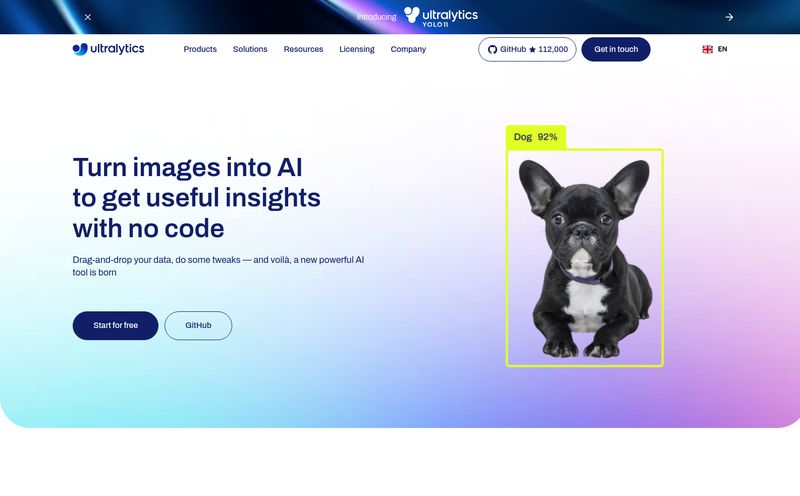If you’re a developer, you probably hate writing documentation. It’s the digital equivalent of doing the dishes after cooking a magnificent seven-course meal. Necessary, sure, but it’s a chore that pulls you away from the creative, problem-solving work you actually love. We’ve all been there, staring at a function we wrote six months ago, with no comments, no context, and thinking, “What on earth was I thinking?”
So, when I hear about a new tool that promises to slay this particular dragon, my ears perk up. The latest name buzzing in the dev productivity space is Mimrr. It’s billed as an AI code documentation solution, a kind of R2-D2 for your codebase, meant to handle the grunt work so you can focus on, you know, fighting the Empire. I was intrigued. I wanted to see the demo, check the pricing, maybe even kick the tires a bit. I navigated my browser to their site and was met with… this.
“Site Not Found.”
Oh, the irony. A tool designed to bring clarity and documentation to complex codebases, and its own digital front door is a 404 page. It’s like a locksmith locking their keys in the car. But as an SEO and tech blogger, this didn’t deter me. It just turned a simple review into a bit of an investigation. What is this ghost in the machine? Let’s piece together what Mimrr is supposed to be.
So, What Exactly is Mimrr Supposed to Be?
Putting aside their current web hosting predicament, the concept behind Mimrr is solid. Based on the digital breadcrumbs I could find, Mimrr is an AI platform designed to integrate directly into a software team’s workflow. Its primary mission is to automate the creation, management, and maintenance of code documentation. Think of it as a tireless intern who actually enjoys documenting your code, writing unit tests, and updating Jira tickets.
It’s not just about adding a few comments here and there. The goal is to free up entire teams—both developers and product managers—from the repetitive, low-level tasks that fragment their focus and slow down the delivery of real, tangible value. For any team lead or CTO who’s ever despaired at the state of their internal docs, this sounds less like a tool and more like a miracle.

Visit Mimrr
The Features That Caught My Eye
A tool is only as good as its features, and Mimrr seems to have a few that genuinely address some major pain points in the software development lifecycle. It’s not just one thing, but a combination of intelligent automations.
More Than Just Comments: AI-Powered Documentation
The core of Mimrr is its ability to generate and, crucially, update documentation automatically. This is the big one. Outdated documentation is arguably worse than no documentation at all. It’s misleading. Mimrr aims to analyze your codebase and keep the docs in sync with the code itself. This could mean consistent, high-quality explanations for functions, classes, and APIs without a developer ever having to manually type them out after a refactor.
Playing Nicely with Others: Key Integrations
I’ve seen too many “revolutionary” tools fail because they live on an island. If a tool doesn’t fit into my existing stack, I’m not using it. Period. Mimrr seems to get this. The platform is built to integrate with the tools we already use every single day: GitHub, GitLab, Azure DevOps, Bitbucket, Slack, and Jira. This is smart. It means the AI-driven insights and automations happen where the work happens, not in some separate, forgotten dashboard. It slots into your CI/CD pipeline and project management flow, which is exactly what you want.
The End of Tedious Tasks?
Beyond documentation, Mimrr claims to automate other soul-crushing tasks. Writing boilerplate for unit tests? Automate it. Creating a detailed Jira ticket from a short request? Let the AI handle the first draft. Reviewing pull requests for style and basic errors? Offload it. This is the kind of stuff that eats up hours of a developer's week. Giving that time back could mean faster sprints, more features, and honestly, a happier and less burnt-out team. It lets senior devs focus on architecture and junior devs focus on learning, not on clerical work.
The Big Deal About Data Privacy
Okay, let's talk about the elephant in the room with any AI tool that touches code: privacy. We've all seen the debates around GitHub Copilot and other large language models. “Is it sending my proprietary code to a third-party server?” “Is it training its next version on my secret sauce?” It's a legitimate, and frankly, terrifying concern for any serious company.
This is where Mimrr seems to be making a stand. One of its headline promises is that it never trains on your data and doesn’t connect to third-party AI solutions. Even better, it can be deployed directly into your own VPC or on-prem infrastructure. For enterprise clients, or anyone in a regulated industry like finance or healthcare, this is a non-negotiable feature. It turns Mimrr from a cool gadget into a viable enterprise solution. This, for me, is perhaps its most compelling feature.
The Good, The Bad, and The... Missing?
So, let's put it all together. On paper, there's a lot to love. The promise of automating away the worst parts of a developer’s job is a powerful one. Improving the quality and consistency of documentation can have a massive impact on team velocity and onboarding new hires. The tight integrations and the actionable insights for management are huge plusses.
But then we have the cons. The most glaring one, obviously, is that their website is down as of this writing. It doesn't inspire a ton of confidence. It might be a temporary glitch, a migration gone wrong, or something else, but it's a bad look. Beyond that, like any powerful tool, it requires some initial setup to integrate it into your workflows. That's not really a con, just a reality. A more substantive consideration is that its effectiveness will likely depend on the quality and structure of your existing codebase. An AI can only do so much with absolute spaghetti code, you know?
What About the Price Tag?
This brings us to the other big mystery: cost. Even when the site was up, the pricing information was notoriously vague. The page had the classic, non-committal marketing speak: “Choose the plan that best fits your needs from startups to enterprise organizations…” This usually means “it’s expensive, and you have to talk to a sales rep.”
I get it, enterprise software sales are complex. But in an era of product-led growth, a lack of transparent pricing is a friction point. I want to know if a tool is in my ballpark before I invest time in a demo. My guess? It's likely a tiered, per-seat license model, with a hefty price tag for the on-prem, enterprise version. But without an actual pricing page, it's all just speculation.
Who is Mimrr Actually For?
Assuming the platform is real and the website comes back online, who should be paying attention? In my opinion, Mimrr isn't for the solo hacker building a side project. It’s for established teams. It’s for the scale-up that just hired 20 new engineers and realized their documentation is a mess. It’s for the large corporation that needs to enforce standards and protect its IP at all costs. It's for any engineering leader who believes that developer time is the most valuable resource they have and is willing to invest in tools that multiply that resource.
Frequently Asked Questions about Mimrr
What does Mimrr do?
Mimrr is an AI tool that automates software development tasks, primarily focusing on creating, updating, and managing code documentation. It also helps automate unit tests, ticket writing, and pull request reviews.
Is Mimrr safe to use with my company's code?
This is one of its main selling points. Mimrr states that it never trains its AI models on your code and does not share data with third-party AI services. It also offers on-premise or VPC deployment for maximum security.
What tools does Mimrr integrate with?
It's designed to work with a standard development stack, including Git providers like GitHub, GitLab, Bitbucket, and Azure DevOps, as well as project management tools like Jira and communication platforms like Slack.
How much does Mimrr cost?
Pricing information is not publicly available. Potential customers likely need to contact their sales team for a quote, with plans tailored for different organization sizes, from startups to large enterprises.
Can Mimrr replace a developer?
Absolutely not. It's a productivity and assistance tool. The goal is to handle repetitive, low-creativity tasks to free up developers to focus on complex problem-solving, architecture, and feature development.
Does Mimrr really never train on my data?
According to their stated policy, yes. This commitment to data privacy is a core part of their value proposition, distinguishing them from other AI tools in teh market.
Final Thoughts on the Ghost in the Machine
My hunt for Mimrr ended in a strange place. I'm left with the blueprint of a potentially fantastic tool, one that addresses a real, persistent pain in the world of software engineering. The focus on privacy and on-prem deployment is incredibly smart, showing a keen awareness of what enterprise customers actually need.
And yet, it's currently a ghost. A collection of promises with a broken front door. I'm genuinely rooting for them. I hope the “Site Not Found” error is just a temporary hiccup on their road to launching a game-changing product. The potential is immense, but potential doesn't fix bugs or write documentation.
I’ll be keeping an eye on Mimrr. If and when it resurfaces, it could be a powerful ally in the endless war against tech debt and bad documentation. But for now, it remains an intriguing mystery.
Reference and Sources
- Mimrr Pricing Page (Inaccessible at time of writing): https://www.mimrr.com/pricing



